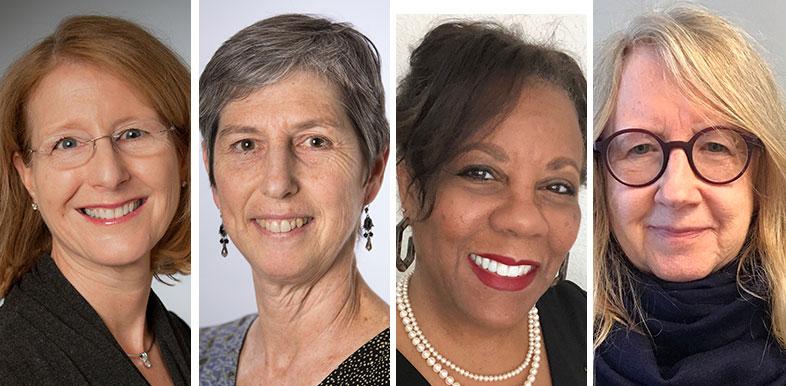
UCSF School of Nursing professors (from left), Linda Franck, Abbey Alkon, Valerie Yerger and Ruth Malone are working on state-funded projects designed to better the health of Californians.
How the UCSF School of Nursing is Changing Health Care in California
Fulfilling the diverse health care needs of Californians requires innovative solutions grounded in evidence-based research.
As it has for decades, California continues to rely on the expertise of UCSF School of Nursing faculty to supply these solutions. The School has secured more than $18 million to fund active state projects that aim to improve the health of newborns, keep children safe and healthy in child care settings, and end tobacco’s dangerous influence, among others. Taking the lead in public health initiatives is a vital role the School’s researchers readily embrace.
“Being a part of the University of California system, I feel as a faculty member we are obliged to give back to our state,” said Abbey Alkon, School of Nursing professor and director of the California Childcare Health Program. “We have an important mission to serve the people of California.”
Providing a Healthy Start
A top priority for California public health officials is ensuring healthy starts for newborns. The state has about 50,000 vulnerable births each year — children born to low-income families who lack access to resources. Quality home visiting services could help reduce that figure.
In 2019, California implemented a state home visiting program, designed to support positive health outcomes for pregnant and parenting people, families and infants born into poverty. Known as the California Work Opportunity and Responsibility to Kids (CalWORKs) Home Visiting Program, it offers prenatal, infant and toddler care, nutrition, and child development screening and assessments, among other services.
Linda Franck, the Jack & Elaine Koehn Endowed Chair in Pediatric Nursing at the School of Nursing, is leading a team that is measuring that program’s effectiveness under a $3 million contract with the California Department of Social Services.
Franck, along with co-principal investigators Jennifer Rienks, Linda Remy and Geraldine Oliva from the UCSF School of Medicine, are analyzing large amounts of data, including birth certificates and hospital records, to measure health outcomes. They are examining the delivery of services, and the experiences and satisfaction of providers and clients. They are also examining the impact of the COVID-19 pandemic on the program staff and clients.
“The hope is that when we present our report to the state, they will use the findings to support the most effective and meaningful aspects of the home visiting services and provide access for more California families,” Franck said.
Seeking a Tobacco Endgame
While the state’s home visiting program began in 2019, California has — for over 30 years and with strong public support — been a leader among states in tackling the tobacco epidemic. Now that the state has achieved the second-lowest smoking prevalence in the country, School of Nursing professor Ruth Malone says it is time to shift focus from tobacco control to ending the tobacco epidemic by addressing the supply side at the community level.
Her work is exploring how to achieve a “tobacco endgame,” by addressing the larger structural, political and social dynamics that sustain the epidemic in California. For example, structural dynamics include the disproportionate density and number of tobacco outlets in communities of color and poorer neighborhoods. Research shows that easy access to tobacco normalizes use and makes relapse more likely among smokers trying to quit.
As far as the political and social dynamics, “it’s important for people to understand this is an industrially produced epidemic, created with the rise of the cigarette industry,” Malone said. “Cigarettes are the single-most deadly consumer product in history, engineered to addict and deadly when used as intended — nothing else comes close. Because of their political influence, the tobacco industry has gotten a pass for 70 years from the types of consumer protection laws that apply to other industries and products. Why should they keep getting a pass?”
California has set a goal of ending the tobacco epidemic by 2035. As part of shifting to this “endgame” focus, the California Department of Public Health awarded a four-year, $2.4 million contract to Malone and her team, including associate professor Patricia McDaniel and professor Elizabeth Smith, to provide educational workshops and technical assistance to California communities working to enact tobacco endgame-related policies. Recently, Malone provided resources and worked closely with advocates in Beverly Hills and Manhattan Beach, two communities which passed the first ordinances phasing out tobacco sales. Malone also serves on the statewide California Tobacco Endgame Expert Advisory Panel.
As tobacco sales continue to drop, revenues from sales and tobacco taxes will also gradually reduce. Malone’s endgame project also addresses the economic impacts through an economic thinktank to identify research needs and forecast how California can continue to fund important programs that are subsidized by tobacco taxes, and through considering how to incentivize retailers toward ending tobacco sales.
Fighting Tobacco Through the LOOP
Malone’s colleagues, like Valerie Yerger, professor in health policy, are working to limit tobacco’s impact in California, especially on marginalized communities.
Yerger leads the LOOP Project, which provides webinars, training and other resources to tobacco control advocates who engage with communities across California to reduce and eliminate tobacco use.
The LOOP’s 30 to 35 subject matter experts perform about 175 presentations annually, said Yerger. Many presentations are designed for underserved populations.
“When people see something wrong, they don’t always know what to do or how to deal with it,” Yerger said. “LOOP provides the tools to deal with social injustices that make people feel otherwise immobilized. We want to be at the forefront of the conversations about equity, racism and the creation of policies that are responsive to individuals disproportionately burdened by tobacco.”
The LOOP’s current contract with the California Department of Public Health — $6 million over five years — is the fifth from the state since the project began in 2014.
Keeping Children Safe in Child Care
While the LOOP Project equips experts to educate communities about the dangers of tobacco, the School’s California Childcare Health Program (CCHP) equips advocates to teach child care professionals about preventive health and safety practices.
Under a three-year, $750,000 contract from the California Department of Education, the program trains health and safety instructors and provides educational materials and technical assistance on topics such as preventing infectious disease, injury prevention, lead poisoning, nutrition, and pest management to a network of about 100 health and safety instructors on the local level. These instructors, in turn, conduct around 1,000 trainings across the state with child care providers every year.
When the COVID-19 pandemic shuttered in-person training sessions, Alkon and her team supplied more training materials online and developed COVID-specific content.
In California, the high demand for child care coupled with less stringent licensing regulations compared to other states, can lead to poor health and behavioral outcomes for children, Alkon said. Equipping child care professionals with the best knowledge and resources is essential.
“This benefits children’s health and safety for years to come,” said Bobbie Rose, CCHP’s child care health consultant. “They develop patterns and habits of good nutrition and physical activity, which can spread to their families.”



